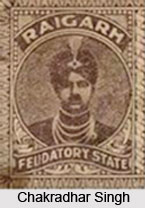 Chakradhar Singh, formally known as Raja Chakradhar Singh, was the Raja of Raigarh and the Chief of Bargarh ruled by Gond dynasty. Raja Chakradhar Singh was the the ruler of Princely State of Raigarh from 1924 till his death in 1947, the time of Independence.
Chakradhar Singh, formally known as Raja Chakradhar Singh, was the Raja of Raigarh and the Chief of Bargarh ruled by Gond dynasty. Raja Chakradhar Singh was the the ruler of Princely State of Raigarh from 1924 till his death in 1947, the time of Independence.
Early Life of Chakradhar Singh
Raja Chakradhar Singh was born on 19th August in the year 1905. He was known as the Raja of Raigarh and Chief of Bargarh ruled by Gond dynasty. Chakradhar Singh was son of Raja Bhup Deo Singh of Raigarh, who died in 1817. Chakradhar Singh completed his education from Rajkumar College, Raipur. He succeeded to throne of Raigarh upon death of his elder brother, Raja Natwar Singh in the year 1924. The government management however continued till the year 1927 when Raja Chakradhar Singh was invested with powers.
Career of Chakradhar Singh
Chakradhar Singh or Raja Chakradhar Singh was a great patron of Indian arts, classical dance, music invited to his capital music and dance-experts from different parts of the country. The contribution has been important in the development of the classical form of Kathak Dance.
Reign of Chakradhar Singh
During the reign of Raja Chakradhar Singh, the exponents of both the gharanas, namely, Jaipur Gharana and Lucknow Gharana gained prominent positions and were patronised by him. Even experts from Benaras gharna were in his court. The Raigarh Gharana of Kathak was established by him during his reign, which produced many luminaries, dancers, singers and musicians due to his patronage and philanthropy. Among the noted Kathak exponents to have served his court were Pandit Jaggannath Prasad of Jaipur Gharana and Guru Kalaka Prasad and his sons of Lucknow Gharana.
Invention of Form of Kathak Dance
Chakradhar Singh or Raja Chakradhar Singh invented a new dance form by mixing different dance forms of Kathak which led to foundation of Raigarh Gharana. Raigarh Gharana thus founded by Raja Chakradhar Singh, although the youngest of all gharanas, has its own compositions of thumris, ghazals, todas and bols which are unique in themselves.
Chakradhar Singh as a Classical Musician
Chakradhar Singh was himself a great exponent of tabla and pakhawaj. Chakradhar Singh or Raja Chakradhar Singh too was a dancer and musician and his patronage extended to all dancers irrespective of their gharana. His name is often taken with Wajid Ali Shah of Awadh as a patron of classical Indian dance and music, especially with respect to Kathak dance and Hindustani classical music. Among the dancers and musicians to have performed or served his court were Pandit Makhan Lal Chaturvedi, Dr. Ramkumar Verma, Pandit Mahaveer Prasad Dwivedi, Pandit Padumlal Punnalal Bakshi. Even Sanskrit language writers like Pandit Sadashiv Das, Pandit Sharda Prasad, Pandit Kashi Dutt Jha served him, through them he translated a lot of music and dance literature in Sanskrit.
Chakradhar Singh in All India Music Conference
In the year 1938, Raja Chakradhar Singh headed the first All India Music Conference held at Allahabad. In All India Music Conference, Raja Chakradhar Singh went with his team of 60 artists. In 1939, All India Music Conference organised a welcome party for Viceroy of India, where Kathak dancer Karthik Kalyan presented the dance and was assisted by Chakradhar Singh, who played tabla. He was given title of Sangeet Samrat by the Viceroy Lord Linlithgow at All India Music Conference. At 1943 All India Music Conference at Khairagarh, Raja Chakradhar Singh again played tabla for the dance performance of Kalyan Das.
Books by Chakradhar Singh
Raja Chakradhar Singh had a very good knowledge of Hindi language, Sanskrit language, Urdu language and Oriya language and has written several books on Indian traditional music like Taalbal Pushpakar, Taal Toynidhi, Nartan Sarwasya, Moorj paran Pushpakar, Raag ratna manjusha And Joshe pharhad, Nigare pharhad, Prem ke teer, Kavya kanan, Mayachakra, Ratnahar, Bairagadiya rajkumar, Alkapuri tilasmi, Ramyaras, Mriganayni.
Death of Chakradhar Singh
Chakaradhar Singh died on 7th October 1947, just after Independence of India. After his death, Lalit Kumar Singh, his son succeeded him to the throne of Raigarh and ruled briefly before the Raigarh State was merged into Union of India on 14th December 1947.




















